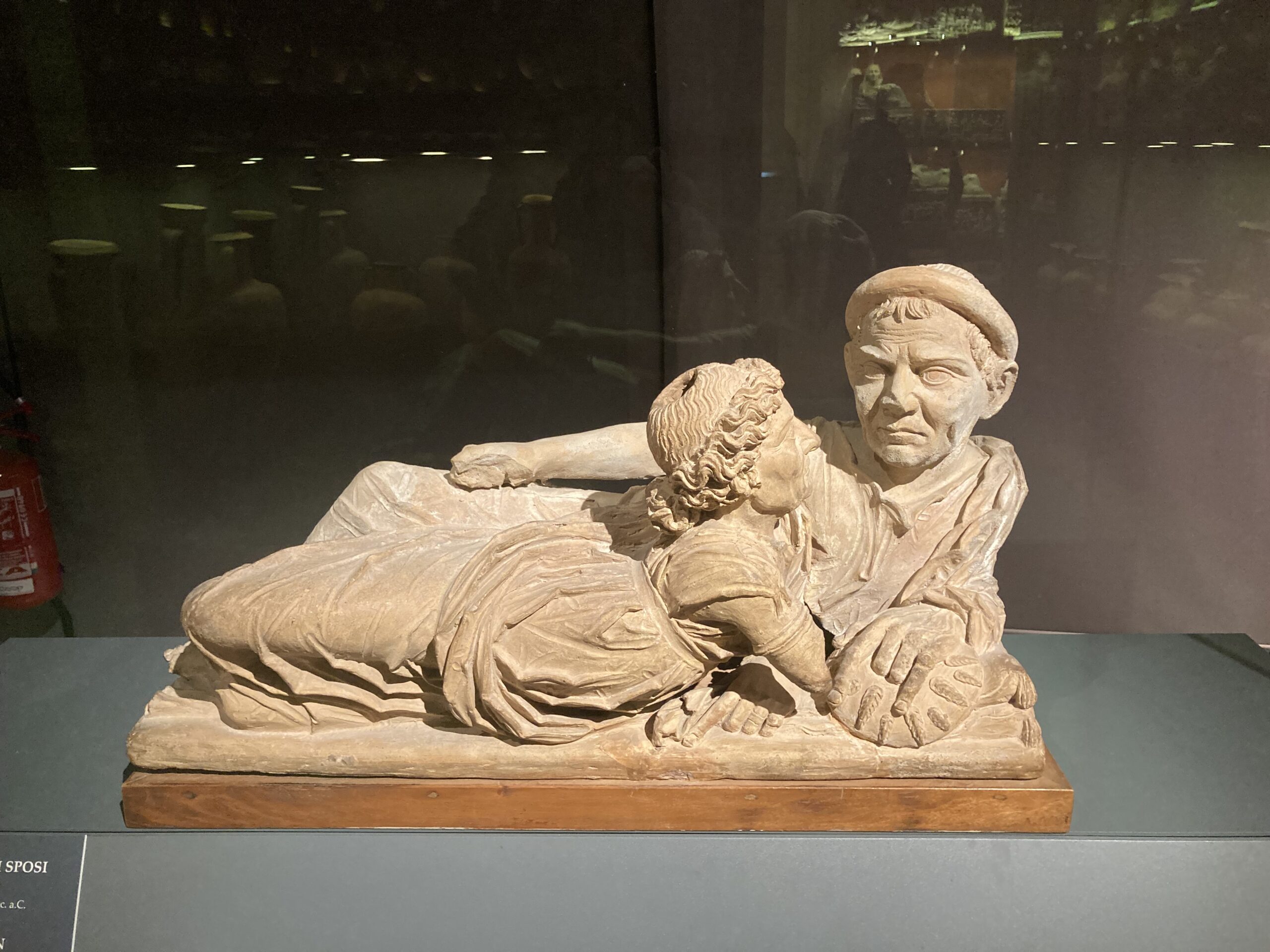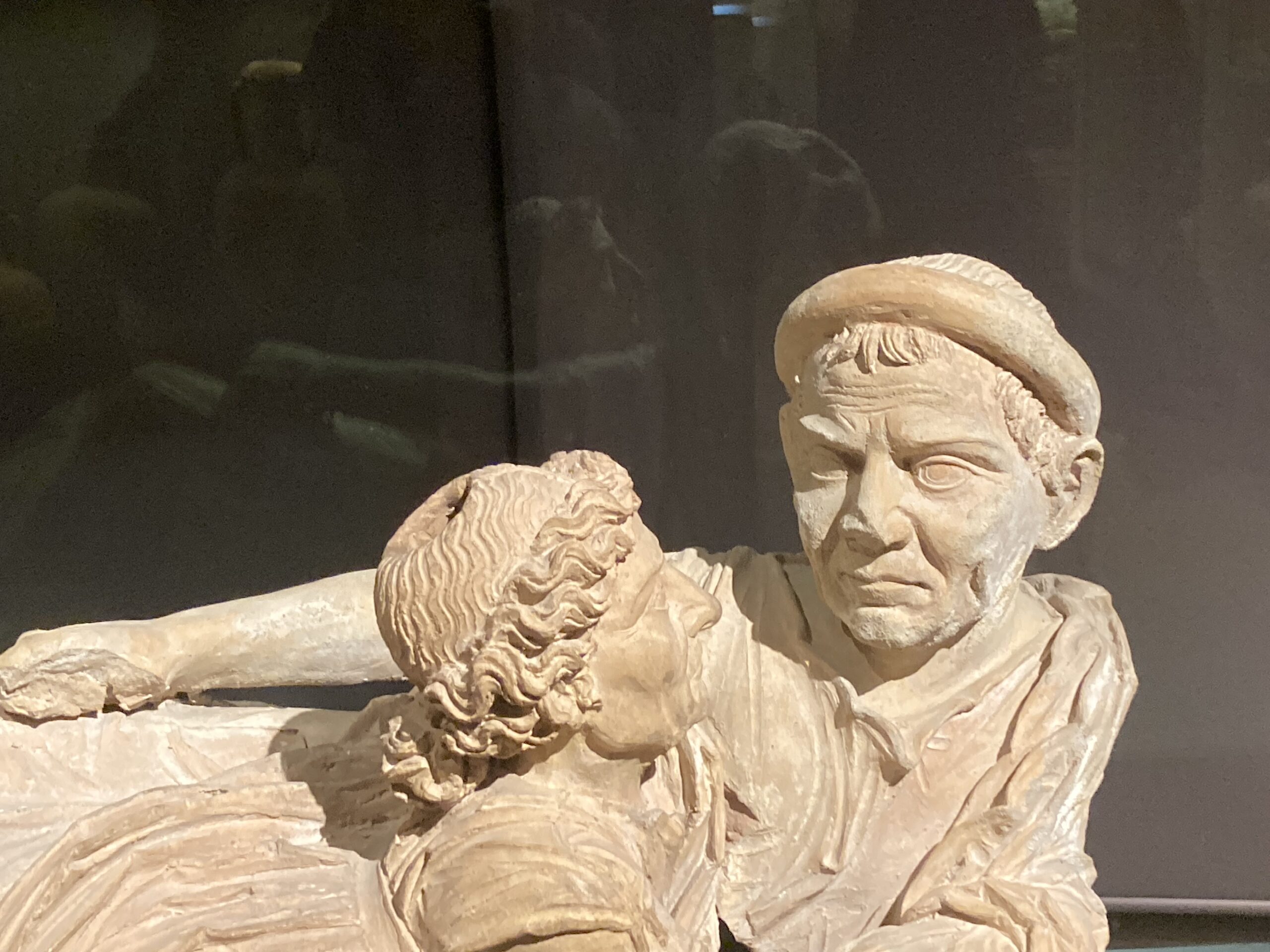
Among the most evocative remnants of Etruscan funerary culture are the terracotta urns that once housed the ashes of the deceased, vessels not only of the body but of memory and identity. Urns featuring reclining couples engaged in a perpetual banquet scene offer a powerful glimpse into Etruscan beliefs about death and the afterlife. These intimate portrayals, often found in burial contexts, reflect a society that viewed death not as an end but as a continuation of life’s pleasures and social bonds. The Elderly Couple from Volterra, a remarkable terracotta lid housed in the Voltera Museo Etrusco Guarnacci, stands as a moving example of this tradition. Depicting a serene, aging pair side by side in eternal repose, the work speaks volumes about affection, legacy, and the Etruscan celebration of human connection beyond the grave.
I visited the Museo Etrusco Guarnacci in April 2025, drawn by its reputation as one of the oldest public museums in Europe, and I was not disappointed. The museum holds a quiet, contemplative atmosphere that feels perfectly suited to its long history and the ancient civilization it celebrates. Housed in the elegant Palazzo Desideri-Tangassi since 1877, the museum is the result of the extraordinary efforts of Mario Guarnacci, an 18th-century Volterran abbot and historian whose passion for antiquity helped preserve the city’s rich Etruscan heritage. Guarnacci’s vision was unusually forward-thinking: he not only amassed a remarkable collection but donated it to the public, ensuring that Volterra’s archaeological treasures remained in local hands and accessible to future generations.
Walking through the galleries, I was struck by the contrast between the museum’s two “souls.” Some rooms retain their 19th-century atmosphere, where rows of urns and shelves of artifacts sit densely arranged according to material or motif, reflecting a historical approach to display. Other sections have been redesigned to offer a modern, more interpretive experience, with carefully selected pieces presented along a chronological path that brings the Etruscan story into clearer focus. The upper floor, dedicated to Hellenistic Volterra, captures the artistic and cultural vitality of the city just before its integration into the Roman world, while the ground floor offers an elegant introduction to its earlier phases, from Villanovan to Classical.
What makes the Museo Guarnacci so special is how naturally it fits within the fabric of Volterra itself. This is a city where history isn’t hidden behind glass, it’s embedded in its walls, streets, and rhythm of life. The museum doesn’t just preserve Etruscan culture, it reinforces the living dialogue between past and present that defines Volterra’s character. Its locally sourced collection, displayed in a building that reflects layers of the city’s own evolution, makes the museum feel less like a separate institution and more like a thoughtful extension of the city’s identity. Visiting it was not just an exploration of ancient artifacts, but of the cultural values that continue to shape Volterra today.
The lid of the so-called Urn of the Elderly Spouses, now one of the most iconic pieces in the Museo Etrusco Guarnacci in Volterra, offers a rare and moving glimpse into Etruscan funerary art. Discovered in 1743 in a chamber tomb at the Ulimeto necropolis, the 41 cm in height terracotta piece, depicts an elderly married couple reclining together on a banquet couch, a klinai, a motif deeply rooted in Etruscan traditions of commemorating the dead as participants in eternal feasting. Intriguingly, both hollow figures feature large openings at the top of their heads, possibly designed for the insertion of ashes, raising the possibility that this piece served not merely as a lid but as the urn itself. The male figure rests in a semi-recumbent pose, while the woman, unusually, lies prone and raises her face toward him, her missing forearm suggesting she may once have been shown in a tender, caressing gesture. Both are dressed in tunics and cloaks, with the woman’s garment sleeveless, and the sculptor emphasized signs of age, wrinkles, sagging cheeks, thinning hair, imbuing the scene with poignant realism. Likely commissioned in the 1st century BC, the work draws on older iconography to evoke dignity, memory, and shared legacy.

Aesthetically, the urn stands apart for its expressive force and quiet originality. Unlike the more standardized examples of Etruscan cinerary sculpture, this piece refuses idealization in favor of a strikingly human portrayal of aging bodies and enduring companionship. The deeply etched facial features, furrowed brows, veined hands, softened flesh, reflect not only technical skill but also a sensitive awareness of the passage of time. Yet, scholars suggest that despite this vivid realism, the work was not intended as a literal portrait of a known Volterran couple. Instead, it follows a stylistic convention of the period: a generalized “type” marked by apparent naturalism, crafted to evoke emotional resonance rather than exact likeness. The result is a powerful blend of personal and symbolic, an image of love, memory, and the continuity of human bonds beyond death. Set within the museum’s broader collection, the Urn of the Elderly Spouses captures the spirit of Etruscan funerary belief while offering a universal meditation on age, intimacy, and the desire to be remembered together.
For a Student Activity, inspired by the Voltera Urn, please… Check HERE!
Bibliography: https://volterratur.it/en/poi/guarnacci-etruscan-museum/ and https://www.facebook.com/groups/archeologyandcivilizations/posts/9143041642455945/